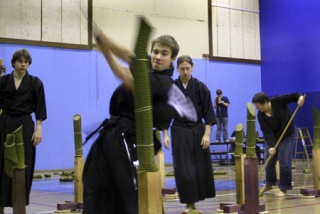Samurai swords conjure images of old Japan, but relatively few use the weapons to test their skill and swordsmanship.
For Aaron McCloud, a 2006 Bainbridge High School graduate, samurai swords are an obsession and a combative art that has become ritual.
“It’s something I am almost manically focused on,” McCloud said. “In high school I used to practice 10 hours on the weekend, so I didn’t really do anything social.”
Last Sunday, McCloud’s obsession earned him a place in the record books as the fastest swordsman to complete “senbongiri” – which translates to “1,000 cuts.”
The test has been attempted by only four other swordsmen in history. It is a testament to the grueling nature of the event and its attraction to a unique niche of sword enthusiasts.
“It’s an amazing feat but by definition there is relatively few people that want to do it,” McCloud said. “Even within the sword community, the amount of people that focus on cutting are very small.”
Tameshigiri is the art of Japanese target cutting with a samurai sword. Targets are usually made of tightly rolled, water-soaked rush mats. Senbongiri, the cutting of 1,000 targets, is considered one of endurance challenges that tests a swordsman’s skill at tameshigiri.
McCloud, a student at Reed College in Portland, completed the feat on Sunday in 33 minutes and 34 seconds, beating the previous record of 36 minutes and 4 seconds held by Isao Machii of Osaka, Japan. The record will have to be reviewed by Guinness World Records before becoming official.
It has taken seven years for McCloud to reach his goal, something he set his sights on early in his training.
“I began when I was 13 years old,” McCloud said. “I think it was early September when my mom came home and said, ‘We’ve found a place for you to do sword fighting.’ In the beginning, I think I was the slowest learner.”
He started practicing under the instruction of sensei Chris Mills of Island Aikido, then, as his interest in sword play evolved, he studied under sensei Russell McCartney of Seattle. In 2000, McCartney performed 1,181 consecutive cuts without a miss in one hour and 25 minutes, setting the record for senbongiri at that time.
For McCloud, taking on the feat was not only a test of his skill but of his ability to stand level with his instructors.
“I wanted to do this to show that young swordsmen can have just as much impact,” he said. “People who have done this before have been over 40, I think I have youth on my side.”
McCloud might be considered an upstart in the world of martial arts. He believes he is more realistic about the benefits of physique over technique, especially in sparring situations and endurance challenges. He also parted ways with his former instructor and began to teach himself, citing differences of opinion.
“They say that technique is everything and strength doesn’t matter,” he said. “It’s only an issue if I face someone of equal strength and endurance, then it becomes a technical contest.”
The only way for McCloud to prove his ability, he said, was to attempt senbongiri, which sets a level field for all those who undertake the challenge.
“It’s hard to find objective standards to test yourself,” he said “Targets are great for that.”
The use of mats to test swords and swordsmanship had a gruesome beginning. Samurai swords were once tested on condemned criminals and cadavers. It is still possible to see etching on older blades, making the amount of limbs or bodies a sword cut through during a test of its quality. Rush mats, when dampened and rolled, are supposed to mimic the density of a human body.
Although there are significantly less moral dilemmas these days for those testing a sword’s durability, McCloud uses a blade that was forged in the early 1800s before the Meiji Revolution – the reaction to Japan’s opening of its isolated borders to the west.
The blade, like many of the materials he used to accomplish his feat, were donated or given at reduced costs to help him toward his goal. He also used the event to benefit the Gynecological Cancer Foundation.
Despite accomplishing the record McCloud admits he set still has much to learn about the art of handling a samurai sword.
“If you are doing one movement 10 million times it begins to look wrong, no matter how perfectly you do it.”



